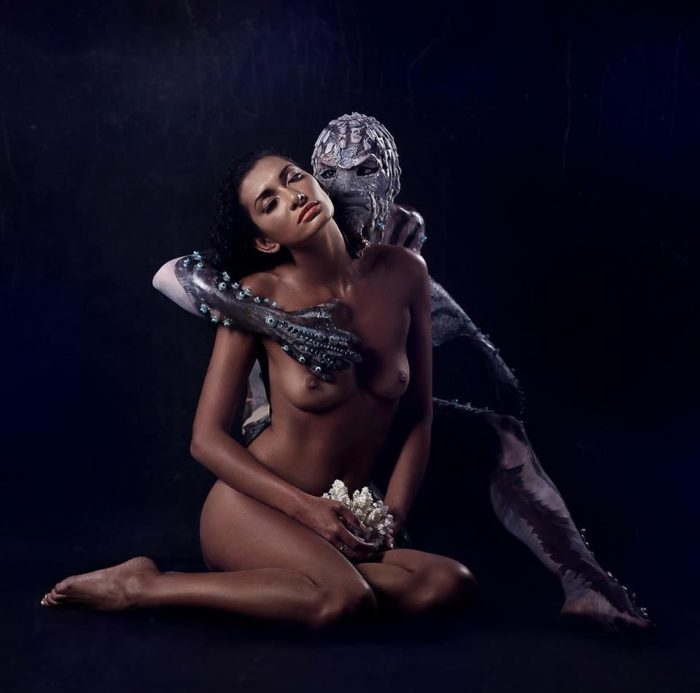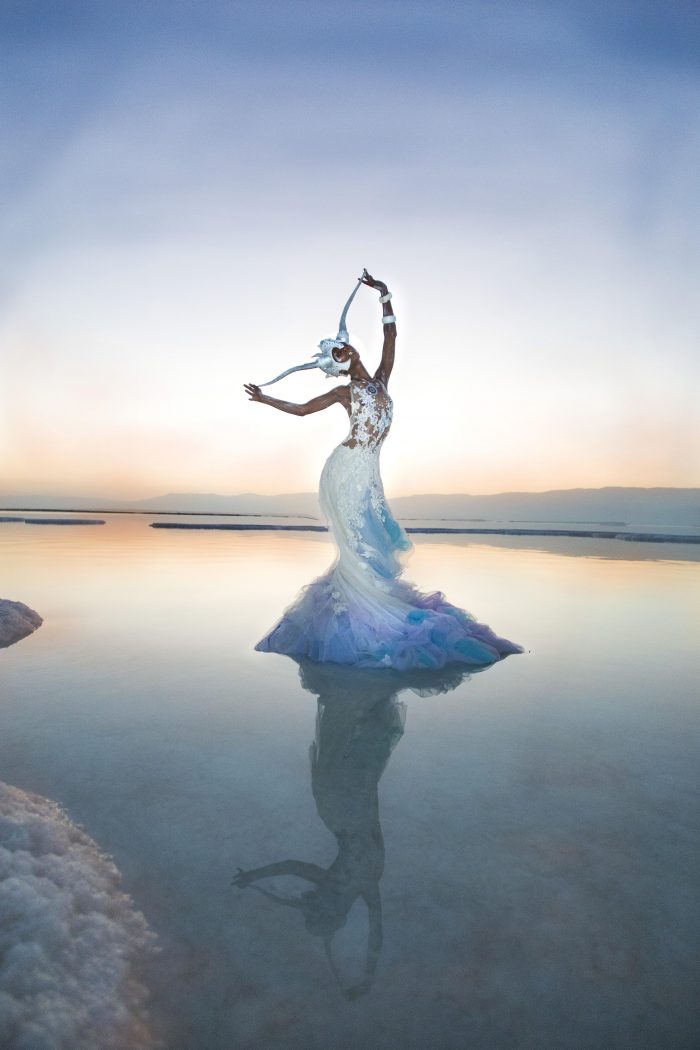From Concept to Execution
The Concept
It’s quiet. To an outside observer, it may look like I’m doing nothing. This is what it looks like when I start a new project. When I work on a new character, I can sometimes do nothing for two or three days.
But this outer quiet is misleading, as my mind never rests during these days. Like a large pot in which morsels of ideas are cooked into a perfect, richly flavored soup.
I’m often asked where my ideas come from.
Where do ideas come from, really?
Sometimes an idea comes up unexpectedly, inspired by a word spoken during a conversation or the sight of a morning ray of light hitting a green leaf; a suggestion from someone around me or a conversation with a stranger. Sometimes, the idea comes from the client.

Model: Anjelica Losk, Marieme Diallo; Photo: Daniel Janesch
When an idea finally presents itself or is commissioned and it’s so exciting I can’t wait to make the dream into a reality. I begin the next phase – researching and processing the knowledge pertaining to the idea’s content world. This phase usually includes gathering information from books, magazines or encyclopedias; and drawing and sketching using different techniques, pursuing different directions that are sometimes unrelated to each other.
This is when the idea matures into the complete creation.
The next phase is much more concrete: I gather ideas that are related to the character in question, such as hairstyle, shoes, gloves, nails, tail, spikes and much, much more. I think about where the painting will be placed on the body itself – the ridges, recesses, curves and creases; and will it go on the limbs, face, chest or back.
Each location has a different meaning, and every decision also affects how the different sections of the illustration will connect and whether the outline of the composition will prove harmonious.

Model: Dmitry Arhganovich, Katerina Kan; Photo: M-studio
Creation
Every piece an artist seeks to execute has inner and outer lines. The outer lines, such as the distance between the eyes or the ratio of the tree compared to the ground are similar to the object, while the inner lines represent the inner world, and express character and feelings, such as joy, peace, rage and aggression. The inner lines are the part that fascinates me the most.
This phase begins after mastering the technical part of the painting and it is here that an important aspect of my work manifests – the decision on what means I will use to express the inner lines of the piece.
We each have our own inner world. Feelings, emotions, images and associations are individual and vary greatly from person to person. As an artist aspiring to express these worlds, if you fail to do so correctly you may find you are misunderstood or rendered undesirable. True, creation should not stem solely from a place of “will I/won’t I be understood or accepted,” but nothing brings an artist a greater sense of joy than knowing he was able to convey his idea to the audience.
For me, a sense of an emotional connection between the audience and work spell success, while indifference and a lack of understanding by the audience spell failure.

Model: Judit Gola; Photographer: Ben Asif
Execution
The world of body Art has unique characteristics that influence how each piece is executed. Personally, I’m averse to time-limited drawing. For a perfect result, I always prefer having more time, but body painting requires you to work fast, here and now.
Body art is like sports, and since a model cannot be made to stand in place indefinitely – models are entitled to a few minutes rest every hour; they cannot be made to pose in a way that is counterintuitive to the natural human form; and bending, crouching or stretching the skin are also undesirable as it changes the proportion of the piece.
For example, in one of the competitions I attended, I drew the face of a child on the model’s back, while she bent forward. When she resumed her pose I was startled by the result: The innocent face I drew became the face of a little monster, with a crooked nose and asymmetrical eyes.
I had to paint the child’s face again and wasted precious time.
I like employing several techniques to one painting. It can be a blend of watercolor and shadowing techniques or using creamy textures, brushing colored pigment or adding powdered paint. Colors should be blended together gently so as to avoid stains and a messy result.
There are certain rules by artists I admire that I always try to follow:
“Don’t use pure black. To get a darker shade, add it to the main color” – Alex Hansen
“Try to get clean lines. Lines should be clear, full and accurate” – Bella Volen
“Don’t let your hand tremble at the end of the line, or your hand will go in the wrong direction. A calm and straight motion will lead it to the end” – Taisia Vasiliva
“Think about your ‘canvas’ and be considerate of her. Make sure she eats and drinks and rest” – Mark Reid
“Remember that you are a perfectly normal person, who creates creative and crazy characters. It’s those who don’t do it who are abnormal” – Fredi Schmid
“Don’t draw the same painting 10 times, but rather work on the details on paper” – Bella Volen
“Love what you do” – Alex Hansen
And I say:
“Don’t flap your hands. Every movement should be justified and lead to the next movement, much like when playing a musical instrument, sports, or cooking a chef’s course” – Lora Tulchinski
“Welcome to the Body Art family” – Wolf Wolfgang Reicherter

Tell me about your techniques. What works for you?
Lora



